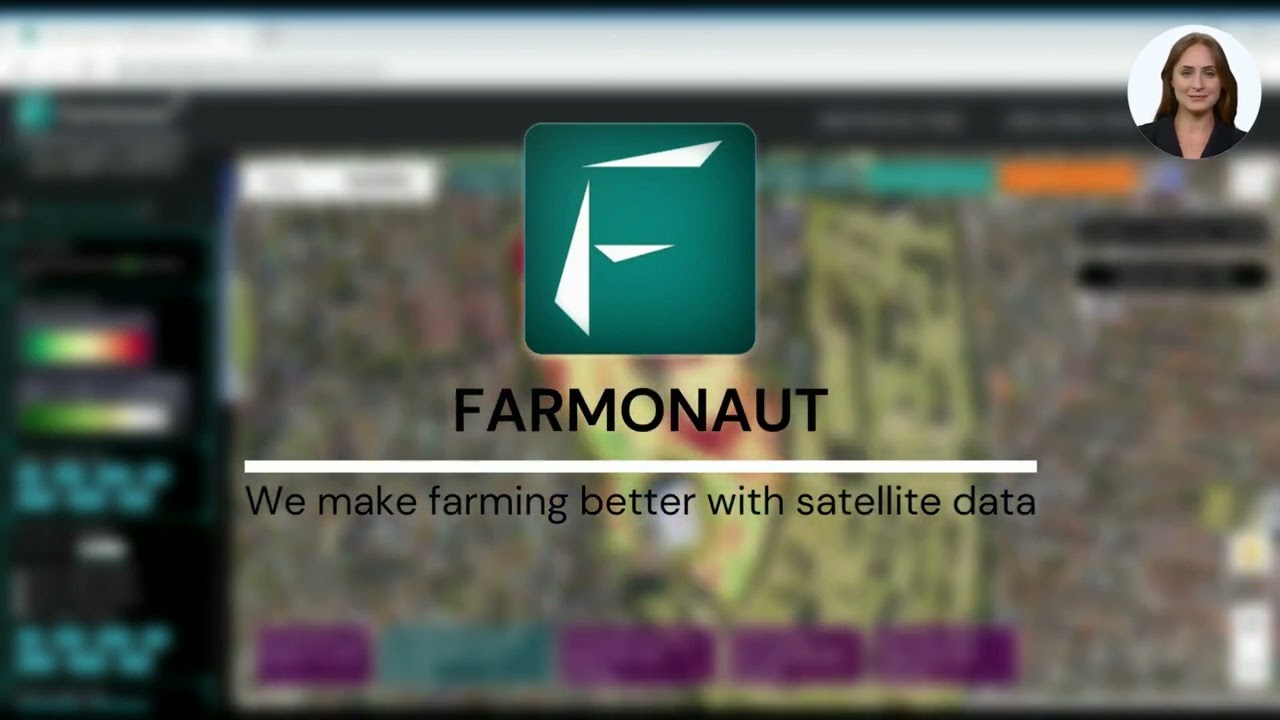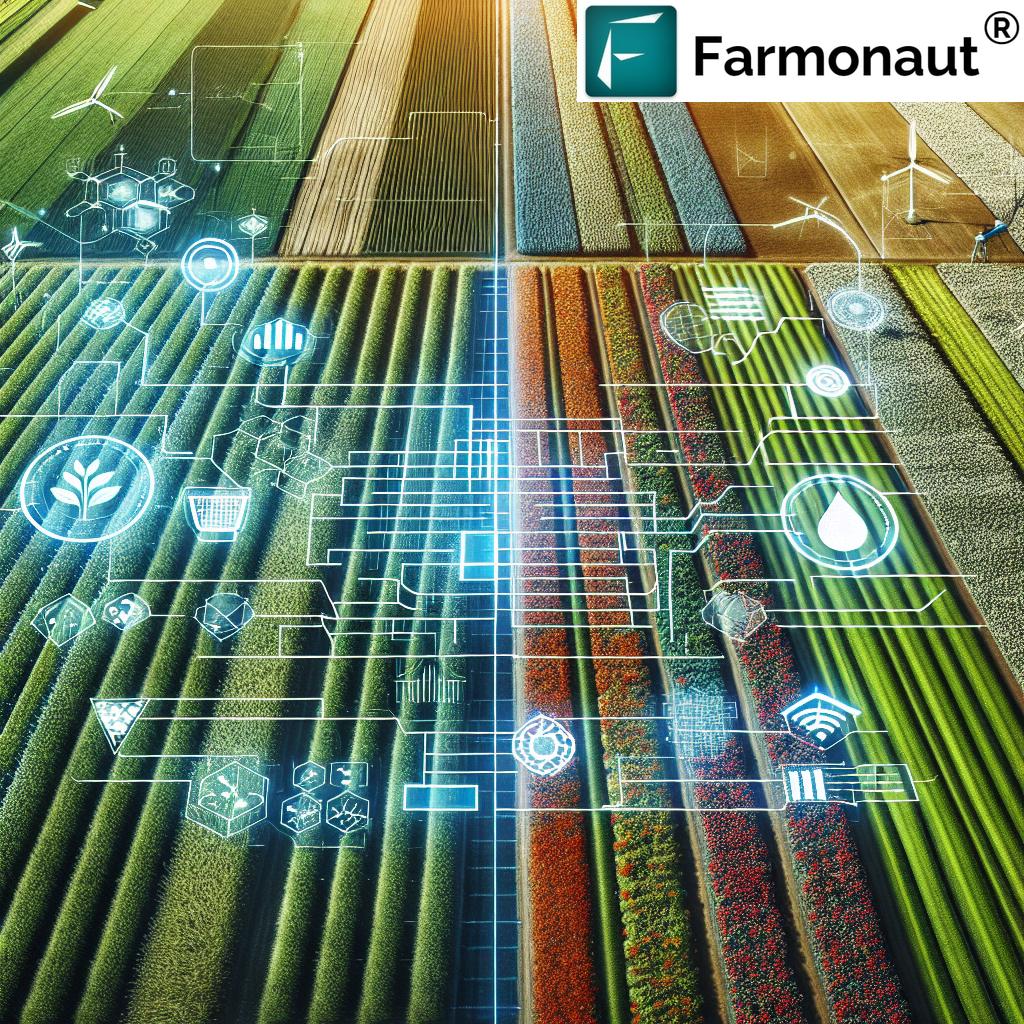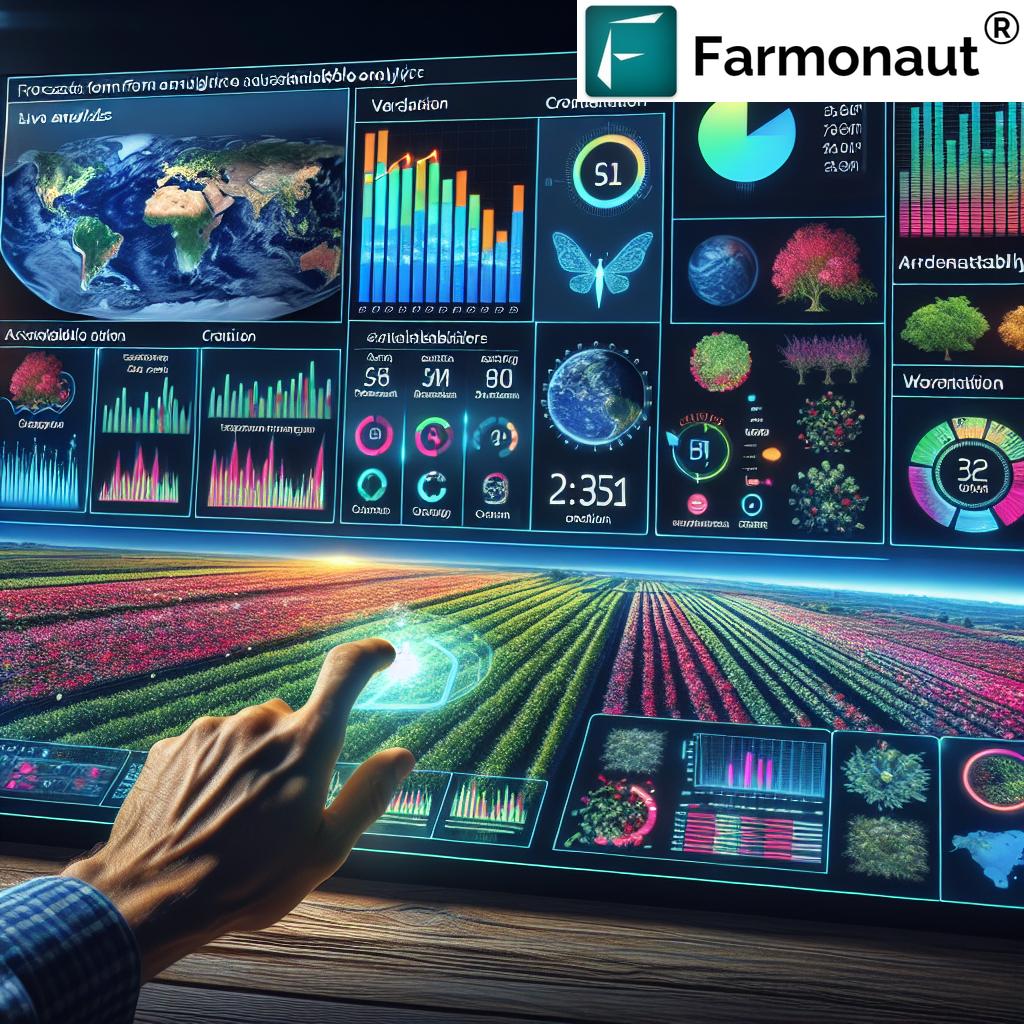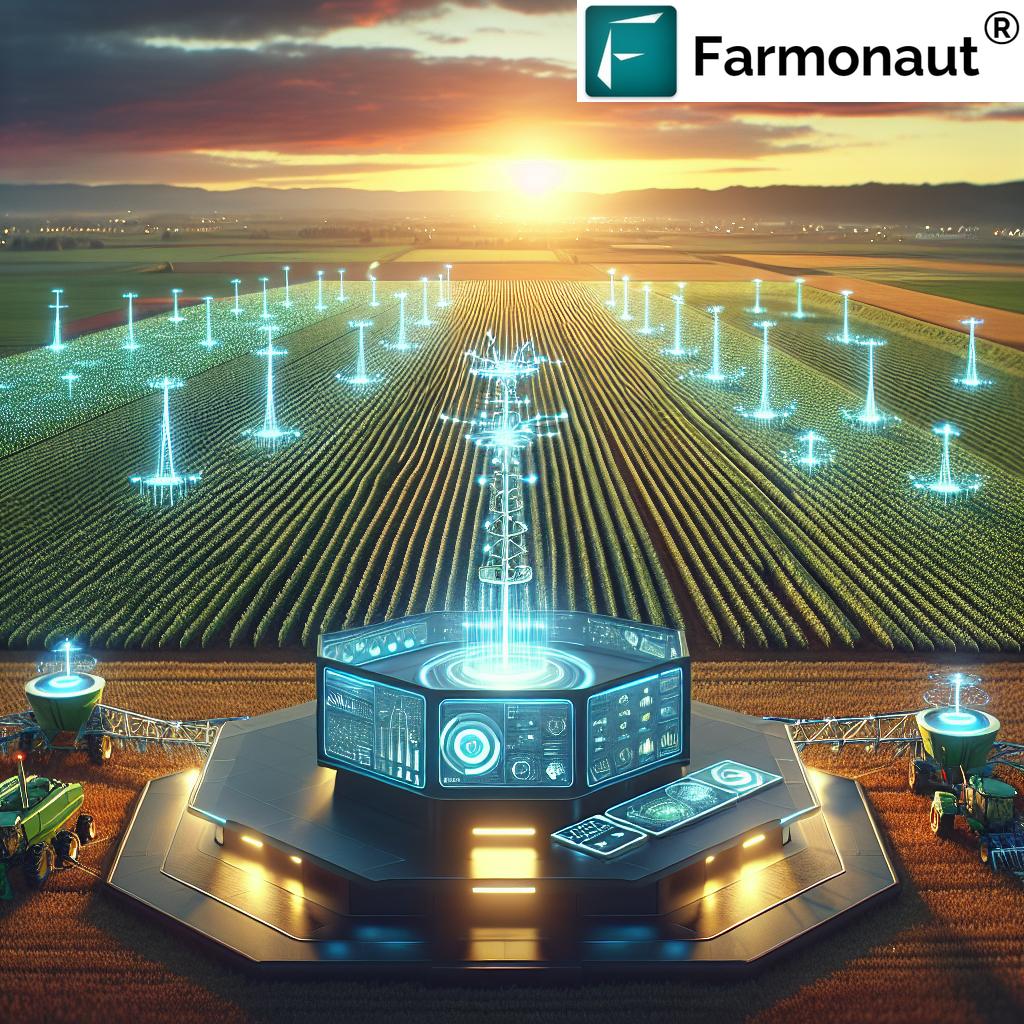Revolutionizing Australian Vineyards: How GIS and AgTech Drive Sustainable Winegrowing and Export Success
“Australian vineyards using GIS-based precision agriculture techniques can reduce water usage by up to 30% while improving grape quality.”
Welcome to our comprehensive exploration of how cutting-edge agricultural technology (AgTech) and Geographic Information Systems (GIS) are transforming the Australian wine industry. In this blog post, we’ll delve into the world of sustainable winegrowing and examine how these innovative tools are boosting export success for Australian wines in the global market.
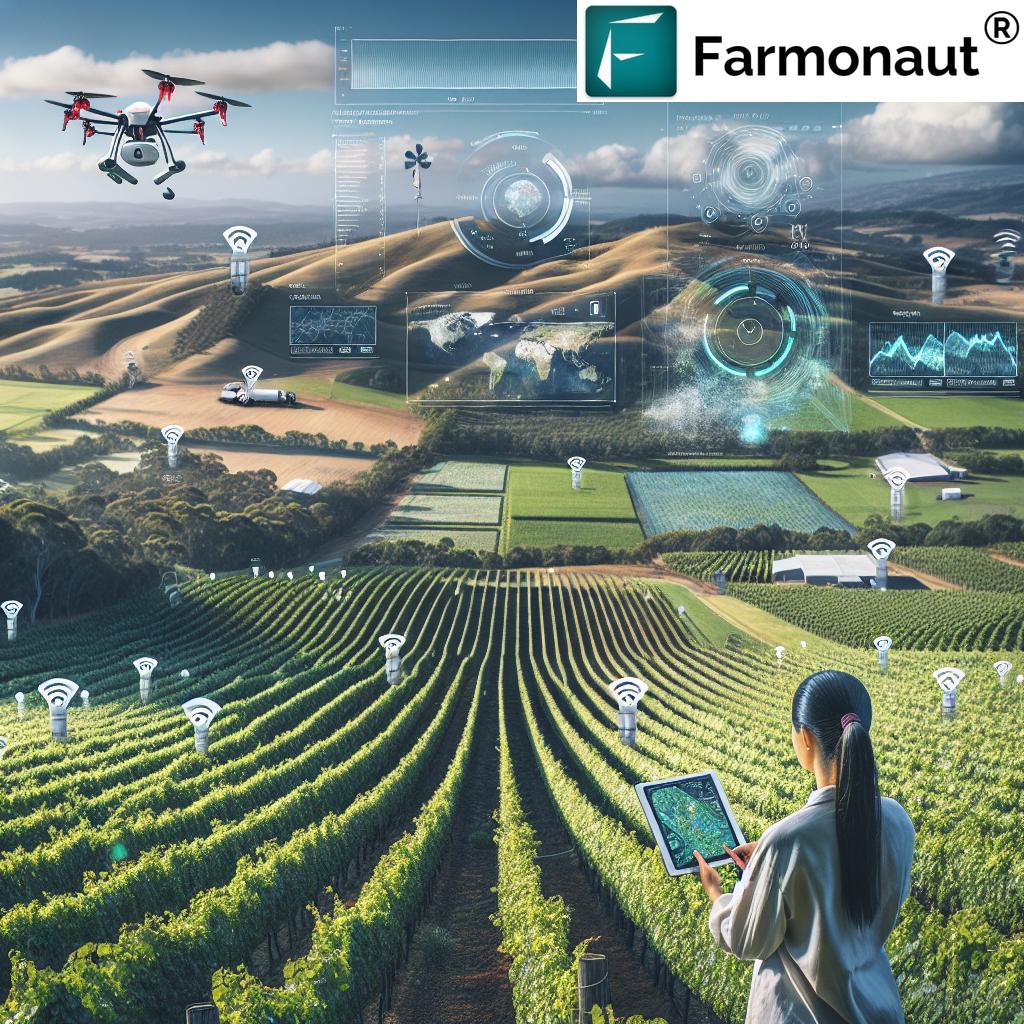
As we navigate through the challenges and opportunities facing the Australian wine sector, we’ll explore how Farmonaut’s AgTech solutions are playing a pivotal role in revolutionizing vineyard management and sustainable practices. From precision viticulture to climate change adaptation, we’ll uncover the latest innovations that are shaping the future of winegrowing in Australia and beyond.
The Australian Wine Industry: A Global Powerhouse
Australia’s wine industry has long been recognized as a global leader, known for its diverse range of high-quality wines and innovative production techniques. With a rich history dating back to the early 19th century, Australian wines have carved out a significant niche in the international market, earning a reputation for their unique character and consistent quality.
- Export success: Australian wines are exported to over 100 countries worldwide.
- Economic impact: The wine industry contributes billions of dollars annually to the Australian economy.
- Regional diversity: From the cool-climate regions of Tasmania to the sun-drenched vineyards of South Australia, the country boasts a wide variety of wine-growing areas.
However, like many agricultural sectors, the Australian wine industry faces numerous challenges, including climate change, water scarcity, and increasing global competition. To maintain its competitive edge and ensure long-term sustainability, the industry is turning to innovative AgTech solutions and GIS applications.
GIS and Precision Viticulture: A Perfect Pairing
Geographic Information Systems (GIS) have revolutionized the way vineyard managers approach their craft. By integrating spatial data with other critical information, GIS enables winegrowers to make more informed decisions and optimize their operations.
Farmonaut’s satellite-based farm management solutions are at the forefront of this technological revolution. Our advanced GIS tools provide vineyard owners with unprecedented insights into their operations, allowing for precise management of resources and improved wine quality.
Key Applications of GIS in Viticulture:
- Soil mapping: Detailed soil analysis helps identify optimal planting locations for different grape varieties.
- Topography analysis: Understanding terrain variations aids in planning drainage and irrigation systems.
- Microclimate monitoring: GIS can track temperature, humidity, and wind patterns across vineyards.
- Yield prediction: Satellite imagery and historical data enable accurate forecasting of grape yields.
By leveraging these GIS capabilities, Australian winegrowers can enhance their vineyard management practices, leading to improved grape quality and more consistent wine production.
Sustainable Winegrowing: A Cornerstone of Modern Viticulture
Sustainability has become a key focus for the Australian wine industry, driven by environmental concerns, consumer demand, and the need for long-term viability. Farmonaut’s AgTech solutions are playing a crucial role in helping vineyards adopt more sustainable practices.
Sustainable Practices Enabled by AgTech:
- Water conservation: Precision irrigation systems reduce water usage while maintaining optimal grape quality.
- Pest management: Early detection and targeted treatments minimize pesticide use.
- Soil health: Advanced soil monitoring helps maintain nutrient balance and reduce fertilizer runoff.
- Energy efficiency: Smart systems optimize energy use in vineyard operations and winemaking processes.
By implementing these sustainable practices, Australian winegrowers are not only reducing their environmental impact but also improving the quality and consistency of their wines.
Climate Change Adaptation: Securing the Future of Australian Wine
Climate change poses significant challenges to the wine industry worldwide, and Australia is no exception. Rising temperatures, changing rainfall patterns, and increased frequency of extreme weather events are altering the traditional wine-growing landscape.
Farmonaut’s advanced satellite monitoring and AI-driven insights are helping Australian vineyards adapt to these changes by providing:
- Real-time climate data: Accurate, localized weather information for informed decision-making.
- Long-term trend analysis: Historical data to identify shifting climate patterns and plan accordingly.
- Risk assessment tools: Predictive models to anticipate and mitigate climate-related risks.
By leveraging these tools, Australian winegrowers can make strategic decisions about grape variety selection, vineyard site planning, and cultivation techniques to ensure the continued success of their operations in a changing climate.

Organic Wine Production: Tapping into Growing Consumer Demand
“Organic wine production, a growing trend in sustainable viticulture, has increased by 70% globally in the last decade.”
The demand for organic wines has surged in recent years, driven by health-conscious consumers and growing environmental awareness. Australian winegrowers are increasingly adopting organic production methods to meet this demand and differentiate their products in the global market.
AgTech Solutions for Organic Winegrowing:
- Natural pest control: AI-powered systems for early detection and biological control methods.
- Cover crop management: Satellite imagery to optimize cover crop planting and maintenance.
- Soil health monitoring: Advanced sensors to track soil organic matter and microbial activity.
- Certification compliance: Digital record-keeping tools to streamline organic certification processes.
By embracing these AgTech solutions, Australian organic wine producers can improve their yields, reduce costs, and ensure compliance with international organic standards.
Navigating the Global Wine Export Market
Exporting wine is a complex process that requires careful planning, adherence to regulations, and strategic marketing. Australian wineries looking to expand their global presence can benefit from AgTech solutions that provide valuable market insights and streamline export processes.
Key Considerations for Wine Exporters:
- Market research: Identifying target markets and understanding consumer preferences.
- Regulatory compliance: Navigating labeling requirements, import regulations, and tariffs.
- Quality control: Ensuring consistent product quality across different markets.
- Logistics management: Optimizing shipping routes and maintaining proper storage conditions.
Farmonaut’s data-driven insights can help wineries make informed decisions about production volumes, quality control, and market targeting, ultimately leading to greater export success.
Explore Farmonaut’s API for advanced data integration
The Role of AgTech in Wine Marketing and Branding
In today’s competitive global wine market, effective marketing and strong branding are essential for success. AgTech solutions are providing Australian wineries with new tools to enhance their marketing efforts and build brand loyalty.
AgTech-Enabled Marketing Strategies:
- Traceability: Blockchain-based systems to provide consumers with detailed product information.
- Virtual vineyard tours: Augmented reality experiences to connect consumers with wine origins.
- Sustainability storytelling: Data-driven narratives highlighting eco-friendly practices.
- Personalized recommendations: AI algorithms to suggest wines based on individual preferences.
By leveraging these innovative marketing tools, Australian wineries can differentiate their products and build stronger connections with consumers around the world.
Access our API Developer Docs for seamless integration
The Future of Australian Winegrowing: Innovations on the Horizon
As we look to the future, the Australian wine industry is poised for continued innovation and growth. Emerging technologies and evolving consumer preferences will shape the next generation of winegrowing practices.
Upcoming Trends in Viticulture:
- AI-driven decision support: Advanced algorithms for optimized vineyard management.
- Robotics and automation: Autonomous systems for pruning, harvesting, and sorting.
- Bioengineering: Development of grape varieties resistant to climate change and diseases.
- Vertical vineyards: Urban winemaking solutions for space-constrained environments.
By staying at the forefront of these technological advancements, Australian winegrowers can maintain their competitive edge in the global market and continue to produce world-class wines.
Farmonaut: Empowering Australian Winegrowers
At Farmonaut, we’re committed to providing cutting-edge AgTech solutions that address the unique challenges faced by Australian winegrowers. Our comprehensive suite of tools includes:
- Satellite-based crop health monitoring: Real-time insights into vineyard conditions.
- AI-powered advisory system: Personalized recommendations for optimal vineyard management.
- Blockchain-based traceability: Ensuring transparency and authenticity in wine production.
- Resource management tools: Optimizing water usage, energy consumption, and labor allocation.
By leveraging Farmonaut’s innovative technologies, Australian wineries can improve their productivity, sustainability, and competitiveness in the global wine market.
Comparative Analysis: Traditional vs. Farmonaut-Enabled Vineyard Management
| Vineyard Management Aspect | Traditional Methods | With Farmonaut Satellite System | Estimated Improvement |
|---|---|---|---|
| Water Management | Manual irrigation scheduling based on visual inspection | Precision irrigation using satellite-based soil moisture data | 30% reduction in water usage |
| Pest Detection | Regular field scouting and manual inspection | Early detection using multispectral imagery and AI analysis | 85% early pest detection rate |
| Yield Prediction | Historical data and manual sampling | AI-driven yield forecasting using satellite imagery and weather data | 95% accuracy in yield predictions |
| Climate Change Adaptation | Reactive approach based on observed changes | Proactive planning using long-term climate trend analysis | 50% increase in climate resilience |
| Resource Allocation | Uniform application of inputs across vineyard | Targeted resource allocation based on precise vineyard zoning | 25% reduction in input costs |
This table clearly demonstrates the significant advantages of implementing Farmonaut’s satellite-based solutions in Australian vineyards. From substantial water savings to improved pest management and more accurate yield predictions, our technology is transforming vineyard operations and driving sustainable growth in the wine industry.
Frequently Asked Questions
- How does GIS technology improve vineyard management?
GIS technology provides detailed spatial data on soil conditions, topography, and microclimate variations within vineyards. This information allows for precise management of resources, optimized planting strategies, and improved overall grape quality. - What are the main benefits of using AgTech solutions in winegrowing?
AgTech solutions offer numerous benefits, including improved resource efficiency, enhanced pest and disease management, better adaptation to climate change, and increased overall productivity and sustainability in vineyard operations. - How can Australian wineries leverage AgTech for export success?
By using AgTech solutions, Australian wineries can ensure consistent quality, improve traceability, optimize production volumes, and gain valuable market insights. These factors contribute to stronger positioning in international markets and increased export success. - What role does sustainability play in modern viticulture?
Sustainability is increasingly important in viticulture, driven by environmental concerns, consumer demand, and the need for long-term industry viability. Sustainable practices, often enabled by AgTech, help reduce environmental impact while improving wine quality and brand reputation. - How is Farmonaut helping Australian winegrowers adapt to climate change?
Farmonaut provides advanced satellite monitoring and AI-driven insights that help winegrowers track climate trends, anticipate risks, and make informed decisions about grape varieties, vineyard planning, and cultivation techniques to ensure resilience in the face of changing climate conditions.
Conclusion: Embracing AgTech for a Thriving Australian Wine Industry
As we’ve explored throughout this blog post, the integration of GIS and AgTech solutions is revolutionizing the Australian wine industry. From sustainable winegrowing practices to enhanced export strategies, these innovative technologies are helping wineries overcome challenges and seize new opportunities in the global market.
By embracing Farmonaut’s cutting-edge AgTech solutions, Australian winegrowers can:
- Optimize resource management and reduce environmental impact
- Improve grape quality and consistency
- Adapt more effectively to climate change
- Enhance traceability and build consumer trust
- Gain valuable insights for strategic decision-making
As the wine industry continues to evolve, those who leverage these technologies will be best positioned to thrive in an increasingly competitive and environmentally conscious market. We invite you to explore how Farmonaut’s solutions can help your vineyard achieve sustainable growth and export success.




